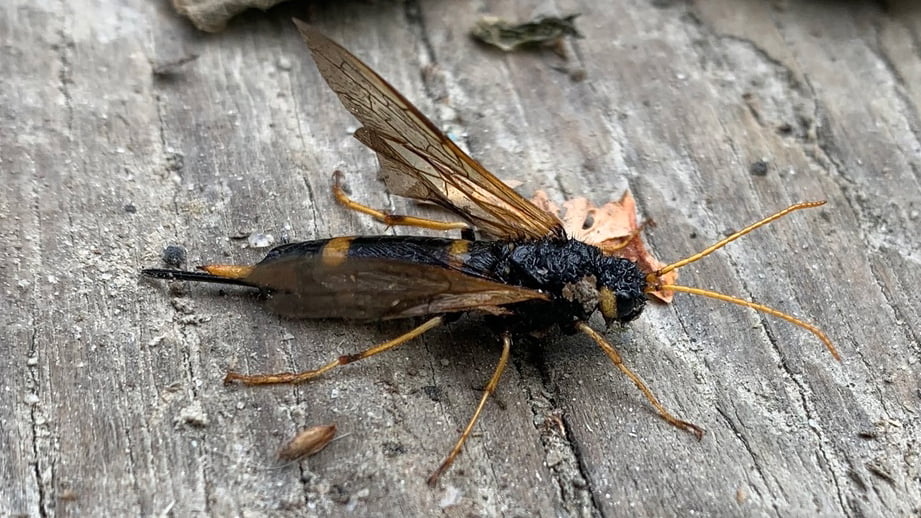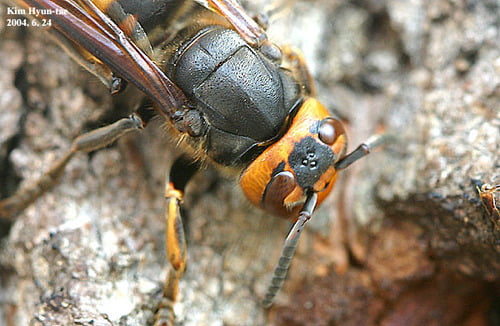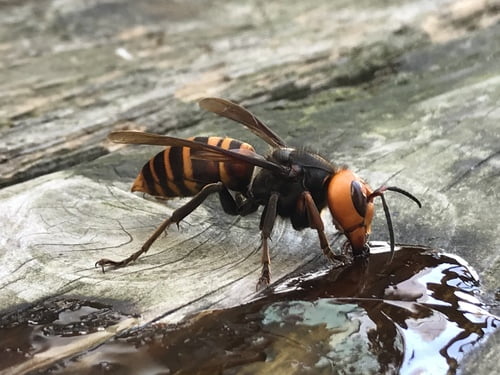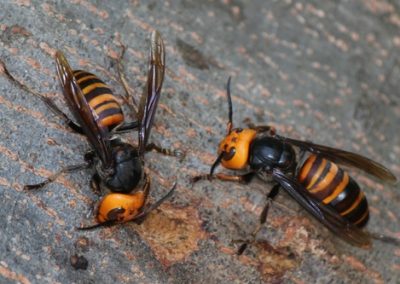
The Dangerous and the Benign: distinguishing between big scary bugs
This article was made possible thanks to support from the Environmental Awareness Fund. Engage and educate yourself in this 10-part blog series, about Yukon Biodiversity.
Banner Photo: Yellow-tailed Horntail. Photo credit: iNaturalist griffontrail in Dawson YT.
12 minute read –
I think we can all agree that the past year has been pretty rough with the fires and the pandemic and the political unrest. When you add the appearance of large and intimidating Asian giant hornets on our fair continent, it makes it feel like we’re living through some biblical plagues. For those of you who have not been hysterically following the news, the Asian giant hornet (aka “the murder hornet”) is a massive hornet that earned its ominous nickname from its fun habit of decapitating hundreds of bees at a time and then carrying off the bee babies (the babees) to feed its own young. Also they sometimes kill people. Yikes. In the spring of 2020, they added to the general calamity that was all of last year by popping up in Washington, DC where the U.S. residents were understandably upset to have this horrible serial killer hornet added to their ecosystem.

iNaturalist observation of an Asian giant hornet. No iNaturalist observations are to date recorded in Canada. Photo Credit (c) Wonwoong Kim, all rights reserved
Obviously, the North American invasion by Asian giant hornets wasn’t kept secret and word traveled all the way to our remote territory. It’s probably because of this news that when a large insect with a prominent “stinger” and suspiciously hornet-like colouring was spotted during the Yukon Wildlife Preserve Bioblitz, some people got very nervous! But fear not, fellow Yukoners! The Yukon is a deeply unappealing habitat for the coast-loving murder hornets. The insect that garnered so much attention at the Bioblitz due to its large, scary appearance and prominent butt-spike is only a threat to felled trees. This benign bug is a horntail also known as a “wood wasp” (of the family Siricidae) and it could not be less like the invasive death machine it was mistaken for.
On the Left: Yellow-tailed Horntail. Found in Yukon. iNaturalist Photo Credit M_Mossop
On the Right: Asian giant Hornet. Not found in Yukon. iNaturalist Photo Credit (c) Alpsdake, some rights reserved (CC BY-SA)
Before we examine these insects in detail, a quick addendum. While scientists and academic types should never let personal bias cloud their research, I am not a scientist nor particularly academic so prepare for some bias. I HATE insects of the wasp/hornet variety. I mean the kind of loathing that would start a centuries long blood feud between families in olden times. Yes, they get props for being pollinators in their spare time but oooooh my god. These stripey menaces ruin every summer outdoor dining experience by completely disregarding your personal space and then rendering your beverage undrinkable after they drown themselves in it. Also, if they sting me, I die and that dynamic would sour any relationship. With that out of the way, let’s meet these bugs!
The Asian giant hornet or Vespa mandarinia (which sounds like a particularly elegant moped) is aptly named as it is the world’s largest hornet! Worker hornets are 3.5 cm long while queens get up to 5 cm. Their wingspans range between 4-7 cm which is probably more bug than the average person wants to deal with. If their size isn’t a giveaway, their large orange heads and black eyes make them very recognizable.

iNaturalist observation Asian giant hornet. Photo credit: (c) Kim, Hyun-tae, some rights reserved (CC BY)
Unlike a lot of other hornets and wasps, these big hornets only nest in the ground. They favour forested areas in coastal environments which is bad news for our west-coast brethren but good news for the Yukon which is notably low on hospitable coastal regions. During the one-year life cycle of a nest, worker hornets usually forage alone and mostly hunt for beetles. The dark and sinister nature of these hornets rears its head in the fall when the colony needs a lot of protein to raise the next generation of queens.
In order to bring in the protein required to beef up their queens, workers abandon solo-foraging missions and band together for group raids. These raids attack high-value targets like the hives of honeybees or even the hives of other hornets. When these raiding parties hit a hive, they decapitate all the adults like they’re doing a re-enactment of the French Revolution then cart off the brood for food. These murder hornets really live up to the moniker as they can kill off thousands of bees in a few hours. Bees are already on a dangerous decline and Asian giant hornets can absolutely devastate local bee populations. This makes their appearance in America and Canada especially concerning.
Although the sudden appearance of murder hornets would be very on-brand for 2020, Asian giant hornets have been in North America before. They were discovered in Nanaimo, BC in August 2019 when beekeepers found a destroyed nest with a whole heap of headless bees outside of it. Their appearance in Washington is just an extension of their coastal conquest. Fortunately, the number of murder hornets in North America is still pretty low. This is good news for humans as people deaths from Asian giant hornets are usually due to disturbing a nest and incurring many stings. Unless you have an allergy (like some people who wrote this article), you have high chances of surviving a murder hornet attack if you have less than fifty stings. Rest easy, I guess? That being said, the Washington State Department of Agriculture had to order special suits to study Asian giant hornets because their massive stingers can pierce through normal beekeeping gear so maybe rest less easily.

iNaturalist image Asian giant hornet. Photo credit: (c) grechan, some rights reserved (CC BY-NC)
It’s time to ease yourself into the warm waters of relief because the horntails that hang out in the Yukon are nothing like this. They’re not invasive, they don’t sting, and unless you’re a dead tree, they pose absolutely zero risk to your health and wellbeing. Yes, wood wasps are also intimidatingly large and similar in size to Asian giant hornets. They range in size between 1-4 cm with females tending to be larger than their male counterparts. Horntails get their name from their cornus: a stinger-shaped plate on the back of their body. Horn. Tail. Geddit? Even though it looks like a stinger, rest assured that it isn’t. Horntails don’t sting or produce venom and don’t really have any defenses other than looking scary. Females in particular look like they have a MASSIVE stinger but it’s actually an ovipositor that helps them lay their eggs into the wood of conifer trees.

iNaturalist image Yellow-tailed Horntail. Whitehorse YT Photo credit: Jake Paleczny
Here’s a fun fact: female horntails have a symbiotic relationship with a fungus! Similar to horntails, basidiomycete wood decay fungi enjoys a nice rotting log. Female horntails help this fungus spread to new locations by carrying bits of it in a specialized pouch on their abdomen. When the female lays her eggs, she also deposits the fungus inside the rotting wood. The horntail also benefits from this arrangement as the larvae get to snack on the fungus after they hatch.
Unlike the newly arrived murder hornet, we’ve probably had horntails in the Yukon as long as we’ve had conifer trees. The reason you might not run into them all the time is that they spend most of their lives inside a tree. After a female lays her hundreds and hundreds of eggs in the wood of a felled or rotting tree, the young hang out in that log for 1-3 years. After they emerge from their timber home as a fully grown adult, they only live for 3-4 weeks! Because they spend so much time in wood, young adults sometimes show up inside people’s homes because the lumber they’ve been tunneling around in has been used as construction material. So they’re not out there murdering bees and giving horrible stings but they can occasionally give you a nasty surprise by exploding out of your new rocking chair.

iNaturalist Yukon. Yellow-tailed Horntail. Photo Credit: Bruce Bennett
I hope your fears are assuaged and you won’t dread painful stings and bee death when you encounter a big scary bug in the Yukon wilds. The horntail might be intimidating in appearance, but it’s a passive insect that just wants to spend most of its life noodling around in a tree. Asian giant hornets are definitely horrible nightmare insects that were probably manifested into existence as punishment for our sins but at least they’re horrible nightmare insects that don’t live up here.

iNaturalist Asian giant hornet resting on human hand. Photo credit: (c) elfsama, some rights reserved (CC BY-NC)
References:
CTV News Vancouver: The murder hornet is in B.C. Here’s how to identify it.
CTV News Vancouver: Asian giant hornets – aka ‘murder hornets’ – expected back in B.C.
Science News: More ‘murder hornets’ are turning up. Here’s what you need to know
The New York Times: ‘Murder Hornets’ in the U.S.: The Rush to Stop the Asian Giant Hornet
Scientific American: Just How Dangerous Is the ‘Murder Hornet’?

Joelle Ingram
Human of Many Talents
Joelle is a former archaeologist, former wildlife interpreter, and a full-time random fact enthusiast. She received her master’s degree in anthropology from McMaster University. One of the four people who read her thesis gave it the glowing review “It’s a paper that would appeal to very specific group of people,” which is probably why only four people have read it. Her favourite land mammal is a muskox, her favourite aquatic mammal is a narwhal. She thinks it’s important that you know that.



Joelle,
My suggestion….. borrow a dissecting microscope and get a freshly killed insect that you find most frightening/disgusting. It will be scary at first but within an hour of examining closely every part of the body, counting leg segments, memorizing the shapes of various mouth parts, antennae, abdominal appendages and claws, you (especially you) will undergo a wondrous transformation. The way the light reflects off the carapace, the amazing engineering involved in the exoskeleton will have you painting, drawing and composing poetry at the very least.
Hi Kathy,
Thanks for your input and engagement with my article! I don’t mean to brag but I have dissected a lot of things over the years and I can assure you that, in my case, gaining a better understanding of an organism rarely creates a greater love for it. I am a deeply cynical human being and that has really worked for me as both a researcher and a writer! That being said, I still think it’s very important to learn more about the world around you even if it skeeves you out.
Thanks for reading!
I am really enjoying Joelle’s articles. Excellent writing and sense of humour!
I’m sure I’ve been stung or bitten by one of the yellow horntails. It was in carmacks, I was sitting on a log taking a break & unknown to me, one landed on my dark grey leggings. It got my attention once I felt a sharp burn like a campfire spark on my leg. Of course I screamed & tried to brush it off but it hung on! It took a few good swipes but it finally went hurtling into the tall grasses nearby. It had made a tiny hole in my leggings & there was a visible mark on my leg from the encounter! I don’t know if it thought I was a piece of wood & was trying to lay it’s eggs but it was frightening & I’m not usually scared of bugs in the Yukon.
Hi Ellenise! This is entirely possible! While horntails have neither an actual stinger or venom (for which we should all be grateful), they can definitely still stab you. This can obviously be painful but in the grand scheme of things, isn’t really dangerous. They can also apparently get confused with what is or isn’t a tree!
I’m sorry that happened to you! I also get freaked out if anything from a person to a bug stabs me so I completely understand your reaction.
Thank you, Elise!
Another great article with humour, intelligence and fantastic info! Thanks so much Joelle!
Thanks, Ellen! I’m so glad you appreciated all my silly articles.